
The Canadian Fitness and Lifestyle Research Institute’s 2022 Parent Survey of Physical Activity and Sport Participation among 5 to 17 year olds asked parents about: their views on the availability of various physical activity and sport facilities in the community; the extent to which these facilities meet the needs of their child; and, the extent to which their child uses these facilities.
The quantity of available local physical activity and sport facilities for children and youth varied widely from 20% of parents reporting that there were many commercial or private facilities through to 60% of parents indicating many parks, trails and green spaces.
Parents were asked about their perceptions about the availability of five types of facilities nearby within the community. Table 1 summarizes the findings in relation to availability.
Table 1: Perception about availability of local physical activity and sport facilities for children and youth
| None | Some | Many | Unsure, not applicable, not during COVID- 19 pandemic | |
| Public facilities (e.g., municipal swimming pools or arenas, playing fields) | 6% | 42% | 31% | 20% |
| Commercial/private facilities (e.g., YM/YWCAs, private gyms, sport and recreation facilities) | 15% | 41% | 20% | 23% |
| Other facilities (e.g., school, faith-based facilities) | 7% | 39% | 37% | 17% |
| Playgrounds | 4% | 31% | 56% | 10% |
| Parks, trails, green spaces | 3% | 30% | 60% | 7% |
Source: 2022 Parent Survey of the Physical Activity and Sport Participation among 5 to 17 year olds, CFLRI
There were few statistically significant differences in parents’ perceptions of availability of at least some local physical activity and sport facilities by the age or gender of their child; a higher percentage of parents of children aged 5 to 11 years indicated that there were at least some playgrounds locally within the community than parents of youth aged 12 to 17 years, however, when examining age combined with the gender of the child, this relationship was significant among girls but not boys.
Parents were asked about their perceptions about the availability of five types of facilities nearby within the community. Table 1 summarizes the findings in relation to availability.
Figure 1: Availability of local physical activity and sport facilities for children and youth (reporting at least some) by age and gender of child
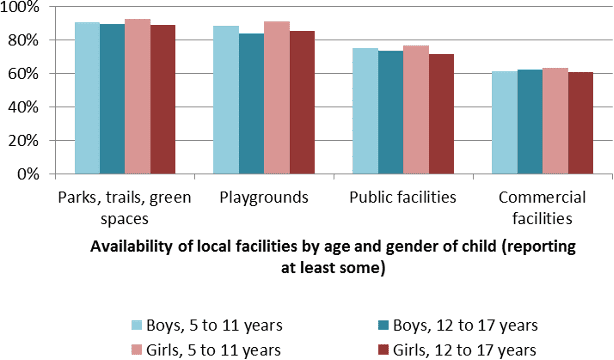
Source: 2022 Parent Survey of the Physical Activity and Sport Participation among 5 to 17 year olds, CFLRI
Parental perceptions about the availability of local physical activity and sport facilities for children and youth were associated with socio-economic factors.
A greater percentage of parents living in the highest income households (≥$100,000 per year) reported that there were at least some public facilities, commercial or private facilities, other community facilities, playgrounds, and parks, trails and green spaces compared to parents living in households in the lowest income households (<$60,000 per year).
Figure 2: Availability of local physical activity and sport facilities for children and youth (reporting at least some) by household income
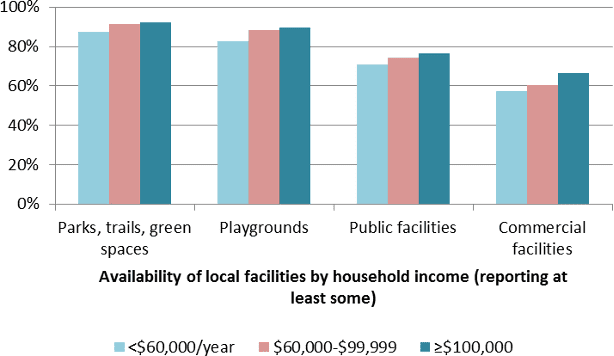
Source: 2022 Parent Survey of the Physical Activity and Sport Participation among 5 to 17 year olds, CFLRI
In addition to measures of household income, perceptions about the availability of certain local facilities were also associated with parental education. For example, a higher percentage of parents with a post- secondary education reported at least some available local public facilities, commercial or private facilities, or other types of community facilities compared to parents who have a secondary school education. In a similar way, relatively more parents with a university education indicated the availability of at least some local parks, trails, and green spaces in comparison to parents with a secondary school education.
Figure 3: Availability of local physical activity and sport facilities for children and youth (reporting at least some) by parental education level

Source: 2022 Parent Survey of the Physical Activity and Sport Participation among 5 to 17 year olds, CFLRI
Furthermore, relatively more parents who were born in Canada have indicated the availability of at least some local playgrounds compared to parents who immigrated to the country for ten years or less.
Certain geographical factors (including community size and province or territory) are associated with perceptions about the availability of specific facilities for physical activity or sport.
Compared to the national average, parents living in Quebec were less likely to indicate the availability of at least some community or private facilities for physical activity and sport; similarly, relatively fewer parents living in Newfoundland and Labrador reported the availability of at least some public facilities and parks and green spaces in the community. On the other hand, relatively more parents living in Saskatchewan have indicated the availability of at least some other types of community facilities that can support physical activity and sport, whereas fewer parents in Quebec reported this, compared to the national average.
There were generally very few relationships between the availability of local physical activity and sport facilities and size of the residing community; a higher percentage of parents living in communities with at least 10,000 residents have reported the availability of commercial or private facilities for physical activity and sport compared to those living in communities with fewer than 10,000 residents.
Figure 4: Availability of local physical activity and sport facilities for children and youth (reporting at least some) by community size

Source: 2022 Parent Survey of the Physical Activity and Sport Participation among 5 to 17 year olds, CFLRI
Beyond availability, the survey also asked parents how the five different types of facilities for physical activity and sport met the needs of their children.
This summary also explores the extent to which parents felt that the five types of local facilities met the needs of their children. Specifically, this refers to: public facilities, such as municipal areas or pools; commercial or private facilities, including privately owned gyms or sport and recreation facilities; other types of facilities, such as school grounds or faith-based facilities; playgrounds; and, parks, trails or green spaces. Table 2 describes the results in detail.
Table 2: Parental perceptions about the extent to which the local physical activity and sport facilities meet the needs of children and youth
| Not at all | Somewhat | Moderate to great extent | Unsure, not applicable, not during COVID-19 pandemic | |
| Public facilities | 11% | 22% | 46% | 21% |
| Commercial/private facilities | 18% | 20% | 33% | 29% |
| Other facilities | 14% | 24% | 40% | 22% |
| Playgrounds | 13% | 20% | 56% | 11% |
| Parks, trails, green spaces | 8% | 21% | 63% | 8% |
Satisfaction with certain types of facilities (e.g. playgrounds, parks, trails, and green spaces) was related to the age of the child and specific gender groups.
A greater percentage of parents of children aged 5 to 11 indicated that public facilities, playgrounds and parks, trails, and green spaces met the needs of their children to at least some extent compared to parents of youth, aged 12 to 17 years. Regarding satisfaction with the local playgrounds, this age-related difference existed for both boys and girls, whereas the age-related differences associated with the satisfaction of public facilities or parks, trails, and green spaces appeared among parents of girls, but not for boys.
Figure 5: Extent that facilities meets needs of children and youth (reporting at least some extent) by age and gender of child
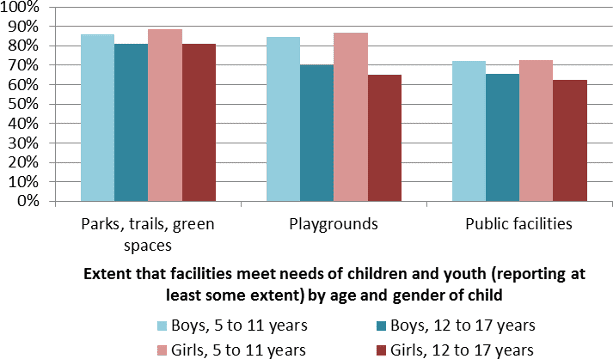
Source: 2022 Parent Survey of the Physical Activity and Sport Participation among 5 to 17 year olds, CFLRI
Similar to results illustrating the differences in availability of facilities, differences also exist with socio-economic factors when looking at the levels of satisfaction with the facilities.
Parents living in the highest income households (≥$100,000 per year) were more likely to say that the public facilities for physical activity and sport, commercial or private facilities, and parks, trails, green spaces at least somewhat met the needs of their children compared to parents living in the lower income households (<$60,000 per year).
Figure 6: Extent that facilities meet needs of children and youth (reporting at least some extent) by household income
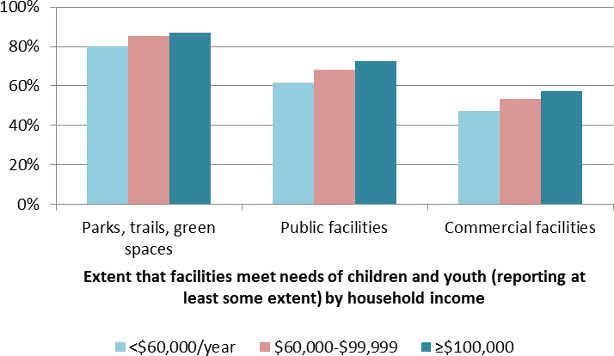
Source: 2022 Parent Survey of the Physical Activity and Sport Participation among 5 to 17 year olds, CFLRI
A greater percentage of parents with a post-secondary education stated that public facilities, commercial or private facilities, or parks, trails, green spaces at least somewhat met the needs of their children compared to parents with a secondary school education. In a similar way, parents with a university education were more likely than parents with a secondary school education to have said that other community facilities at least somewhat met their children’s needs.
Figure 7: Extent that facilities meet needs of children and youth (reporting at least some extent) by parental education level

*Data suppressed due to cell size.
Source: 2022 Parent Survey of the Physical Activity and Sport Participation among 5 to 17 year olds, CFLRI
Relatively fewer parents who were born in Canada have reported that they were at least somewhat satisfied with the commercial or private facilities for physical activity or sport, compared to parents who have immigrated to the country within the past fifteen years. There were, however, no differences between Canadian-born parents and those who have immigrated to the country more than fifteen years ago. Similarly, Canadian-born parents were less likely to state that the playgrounds and other community facilities at least somewhat met the needs of their children compared to parents who have immigrated to Canada between five and fifteen years ago; there were no significant differences between Canadian-born parents and those who have immigrated more than fifteen years ago or those who immigrated less than five years ago.
Figure 8: Extent that facilities meet needs of children and youth (reporting at least some extent) by parental immigration status

Source: 2022 Parent Survey of the Physical Activity and Sport Participation among 5 to 17 year olds, CFLRI
There were some differences in levels of satisfaction with geographical factors.
A larger percentage of parents living in larger communities (10,000 or more residents) have reported that the commercial or private facilities for physical activity and sport, or playgrounds at least somewhat met the needs of their children compared to parents from smaller communities (<10,000 residents).
Figure 9: Extent that facilities meet needs of children and youth (reporting at least some extent) by community size
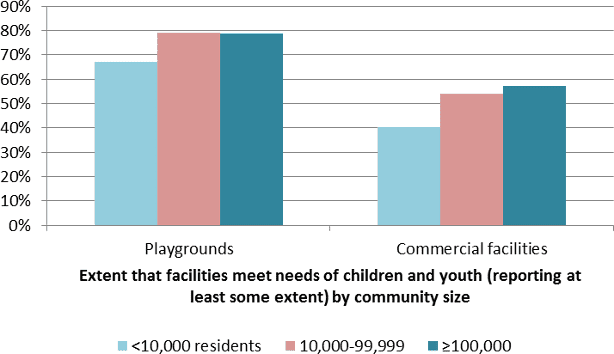
Source: 2022 Parent Survey of the Physical Activity and Sport Participation among 5 to 17 year olds, CFLRI
Compared to the national average, relatively fewer parents living in Quebec reported that they were at least somewhat satisfied with the commercial or private facilities or other community facilities, and fewer parents living in Manitoba indicated that they felt that the parks, trails, and green spaces at least somewhat met the needs of their children. Relatively more parents living in Saskatchewan stated that other community facilities at least somewhat met the needs of their children when compared to the Canadian average.
Less than half of parents reported that their child uses local physical activity and sport facilities to a moderate or great extent.
Lastly, the survey also explored parental reports about the extent that their children used the five various types of facilities. The specific findings are described in Table 3.
Table 3: Parental perceptions about the use of local physical activity and sport facilities by children and youth
| Not at all or little | Somewhat | Moderate to great extent | Unsure, not applicable, not during pandemic | |
| Public facilities | 30% | 22% | 29% | 19% |
| Commercial/private facilities | 44% | 14% | 20% | 22% |
| Other facilities | 33% | 20% | 29% | 17% |
| Playgrounds | 25% | 23% | 43% | 9% |
| Parks, trails, green spaces | 19% | 28% | 46% | 7% |
Source: 2022 Parent Survey of the Physical Activity and Sport Participation among 5 to 17 year olds, CFLRI
Children were more likely than youth to use public facilities, playgrounds, or parks, trails and green spaces to at least some extent.
A larger percentage of parents of children, aged 5 to 11 years, reported that their children used public facilities, playgrounds, or parks, trails and green spaces to at least some extent compared to parents of youth, aged 12 to 17 years. These age-related differences appeared for both boys and girls. In terms of gender, relatively more boys than girls use public facilities to at least some extent, and this relationship was significant for youth, but not children. Although parents of children were more likely than parents of youth to have said that their children use other communities facilities to at least some extent, this age-related difference was significant only for girls, not boys.
Figure 10: Usage of facilities (reporting at least some extent) by age and gender of child
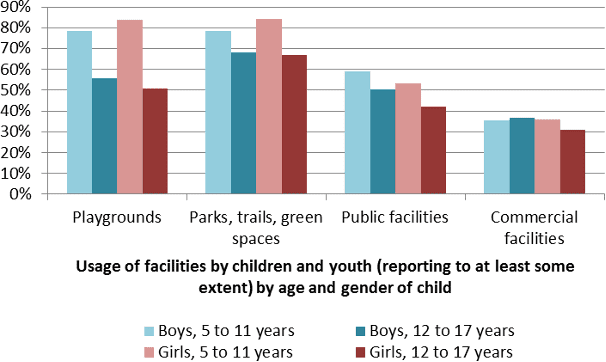
Source: 2022 Parent Survey of the Physical Activity and Sport Participation among 5 to 17 year olds, CFLRI
There were relatively few significant relationships between socio-economic factors and the use of various types of facilities.
Relatively more parents living in the highest income households (≥$100,000 per year) stated that their children use public facilities for physical activity and sport to at least some extent, compared to parents living in lower income households (<$60,000 per year).
Figure 11: Use of a coach in sport by children and youth, aged 5 to 17 years, by parental education level
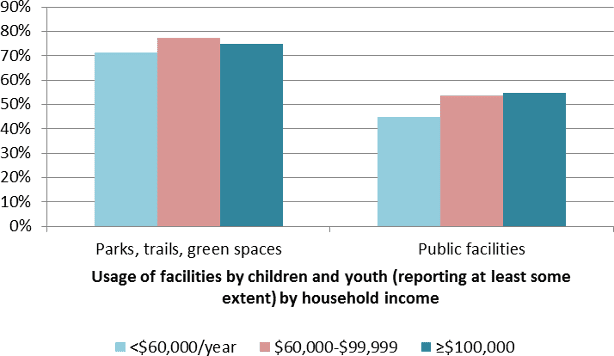
Source: 2022 Parent Survey of the Physical Activity and Sport Participation among 5 to 17 year olds, CFLRI
Moreover, parents with a university education were more likely than those with a secondary school education to have reported that they children use public facilities, commercial or private facilities, or other community facilities to at least some extent.
Figure 12: Usage of facilities (reporting at least some extent) by parental education level
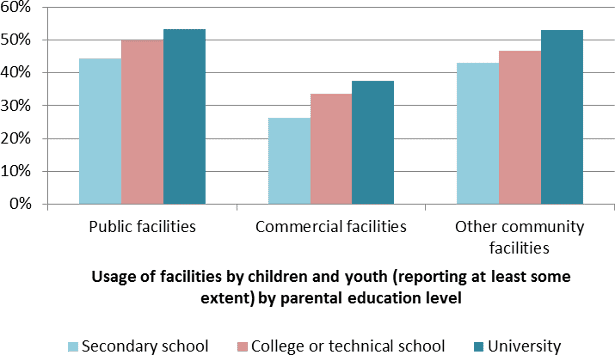
Source: 2022 Parent Survey of the Physical Activity and Sport Participation among 5 to 17 year olds, CFLRI
Relatively fewer parents born in Canada said that their children use public facilities or playgrounds to at least some extent compared to parents who immigrated to the countries between five and fifteen years ago. There were, however, no differences between Canadian-born parents and parents who immigrated either more than fifteen years ago, or else who immigrated less than five years ago. Regardless of the year of immigration, parents who immigrated to the country were more likely than Canadian-born parents to have reported that their children used commercial or private facilities and other community facilities to at least some extent.
Figure 13: Usage of facilities by children and youth (reporting at least some extent) by parental immigration status
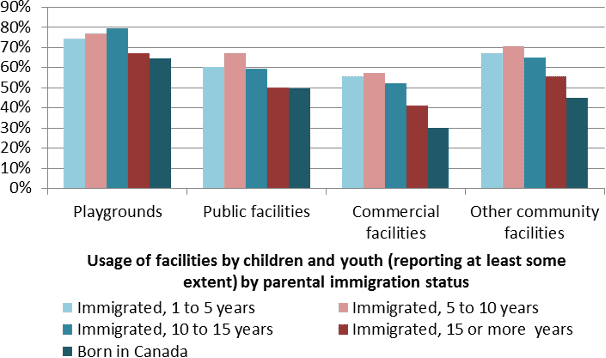
Source: 2022 Parent Survey of the Physical Activity and Sport Participation among 5 to 17 year olds, CFLRI
Differences in usage of various physical activity and sport facilities varied depending on where children lived.
Compared to parents living in smaller communities (<10,000 residents), parents living in larger communities (at least 10,000 residents) were more likely to have stated that their children use commercial or private facilities to at least some extent. In a similar way, a greater percentage of parents living in the largest communities (at least 100,000 residents) said that their children use playgrounds to at least some extent when compared to parents living in the smallest communities (<10,000 residents).
Figure 14: Usage of facilities by children and youth (reporting at least some extent) by community size
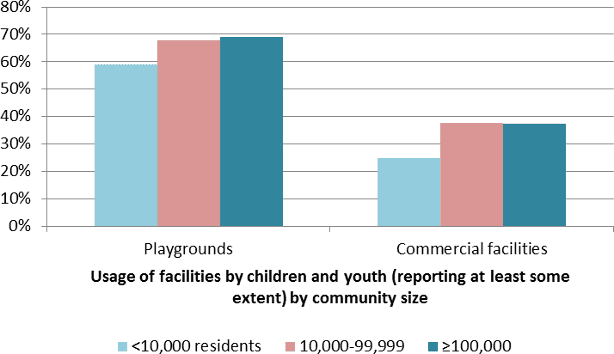
Source: 2022 Parent Survey of the Physical Activity and Sport Participation among 5 to 17 year olds, CFLRI
Differences also exist in usage of facilities by children, depending on where they live in the country. Compared to the national average, fewer parents living in Quebec said that their child used commercial or private facilities, playgrounds, parks, trails, and green spaces, or other community facilities to at least some extent. Similarly, parents living in Newfoundland and Labrador were less likely to have reported that their children used playgrounds to at least some extent, whereas parents living in Saskatchewan were more likely to report their children’s usage of other community facilities, when compared to the national average.
Production of this summary has been made possible through a financial contribution from the Government of Canada. The views expressed herein do not necessarily represent their views.


